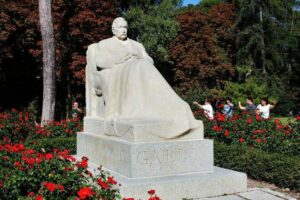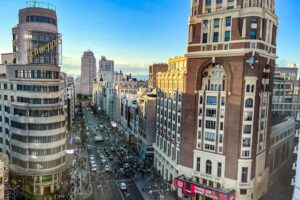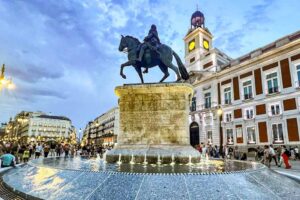Without a doubt, the great prominence of the exhibitions in Madrid during this end of the year 2011 is the Hermitage exhibition at the Prado museum.
After having the opportunity to visit it, I am going to tell you what it is like and my impressions about the exhibition en Madrid of works of art from the famous Russian cultural institution.
The first consideration is the advice that, in advance, book tickets online, because it is the best way to skip the lines to visit the Hermitage exhibition.
When presenting the exhibition, the Prado Museum wanted to emulate the imperial atmosphere characteristic of the great museum of Saint Petersburg, with warm colors in its room.
I have not yet had the opportunity to visit the Hermitage museum, but the beginning of the exhibition at the Prado It precisely focuses on explaining the great importance and majesty of the Ruta cultural institution.
At first you will see three large portraits of Peter I the Great, Catherine the Great and Nicholas I, who were key in the birth and development of the Hermitage.
Peter I was the tsar who decided to found the city of Saint Petersburg in 1703, next to the Baltic Sea.
Catherine the Great was the creator and promoter of the museum, when after becoming empress of Russia in 1762, she settled in the newly built Winter palace of the imperial city, and acquired the first collections of works of art to decorate said palace.

Subsequently, he promoted the construction of the other palaces that currently make up the large complex of Hermitage buildings.
For his part, Nicholas I was the tsar who in 1852 decided to convert the Hermitage into a museum that housed all the imperial collections of works of art.
And finally, after the Russian revolution of 1917, the Hermitage collection of works It grew substantially after the nationalization of private and aristocratic collections.
In the Prado exhibition, several paintings by the Swedish painter Patterson, from the late 19th century, will show you exterior landscapes of the Hermitage and Saint Petersburg.
And you will also be able to see the inner majesty of these imperial palaces through other paintings by Russian artists of the 19th century.

But although the Hermitage is considered the second most important art gallery in the world, after the Prado Museum itself, it is actually a great encyclopedic museum.
Thus, in the next room they show gold objects from nomadic tribes of Eurasia, from the 7th to 3rd centuries BC, from archaeological excavations in Siberia, with ornaments, brooches, bracelets...
And then, gold objects from Greek culture, recovered on the Bosphorus peninsula.
The next room is dedicated to a sample of european painting from the 13th century, with drawings by Dürer, Flemish painting by Rembrandt, Spanish, with works by Velazquez and El Greco, and Italian, of which the San Sebastián of Titian and the lute player by Caravaggio.
The following rooms are dedicated to the Hermitage as the setting for the Russian court, with various objects, such as a ceremonial dress and a gala military uniform.
Of note is the large centerpiece of French origin, from the end of the 4.000th century, and the large porphyry vase, from the mid-XNUMXth century, a quartz rock carved in Siberia and later transported XNUMX kilometers to reach Saint Petersburg.

Also, I'm sure you like the work. The Kreuzkirche in Dresden, Lutheran church of the German city, painted by Bellotto in 1752, and the sculpture The penitent Magdalene by Antonio Canova.
Your visit to the first floor of the Hermitage exhibition is completed with a sample of decorative arts of the East and West, specifically, with jewelry, ornaments, vases, chalices and other objects from China, India, Central Asia and Europe.
ORGANIZE your TRIP
- Don't forget your TRAVEL INSURANCE with a 5% discount
- Book the HOTEL for your trip
- RENT a CAR for your trip
- The best TOURS and EXCURSIONS in Spanish
- NO-LINE TICKETS for museums and monuments
- Best FREE TOURS around the world
- Book your TRANSFER from the airport
- eSIM card with INTERNET at the best price
Next you must go up to the second floor, in whose rooms you will find paintings from the 19th and 20th centuries. Here you will see works by Monet, Guaguin, Zuloaga, Picasso, Cezanne, Matisse, Morandi and, finally, a large painting by Kandinsky, considered the creator of abstract painting.
After finishing watching the Hermitage exhibition, it will surely make you want to visit this great museum in Saint Petersburg, to see the works of art in their original setting, the great Winter Palace.
And, finally, you can take the opportunity to complete your visit to the Prado by going up to the third floor of the museum extension, where you can see the cloister of the Jerónimos church, 2000th century. Rebuilt after the renovation by Rafael Moneo in XNUMX, it is one of the few constructions from the period of the Madrid of the Austrias that remain in the city.
















My congratulations for the guidance provided on the existing works of art in the Prado Museum
excellent information provided